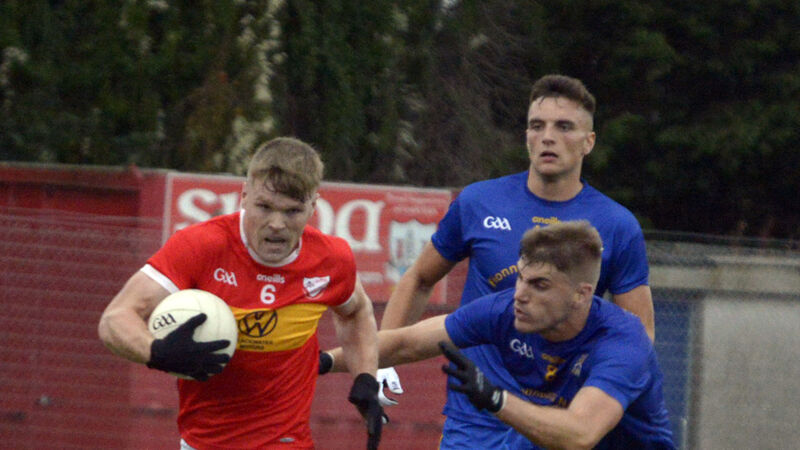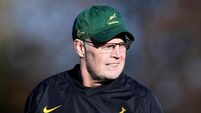Paul Rouse: Why the rush to condemn the split season before it has even been completed?

CLUB ACTION: Cork stars - St. Finbarr's Ian Maguire tackles Eire Og's John Cooper. Pic: Denis Boyle
the night after the All-Ireland hurling final, Dónal Óg Cusack gave an extended speech on the Sunday Game decrying the inter-county season finishing in the middle of July.
The core of his argument appears to be that in fixing its All-Ireland finals for July, the GAA was denying people the chance to see top players playing the game on television for much of the year and that players were being rushed through championships. His related point was that hurling was being squeezed in the newspapers and on TV by other sports, at least partly because it was clashing with other major sporting events. The overall point was that there was a need for more “oxygen” to be given to hurling as a sport.
Cusack is entitled to express this opinion, of course, and there is no doubting the sincerity of his position.
But it is fair also to expect that he should have been challenged on his views that night. This did not happen.
Similarly, this week, there was more confused thinking. The brilliant former Mayo footballer and current TD Alan Dillon is an intelligent, articulate man who has had very interesting things to say about, for example, affordable housing schemes and plans to mitigate recent cost-of-living increases.
But his comments calling for the inter-county championship to be stretched out across August and September were shallow and contradictory.
To be clear, there is no doubt that the split season is an imperfect solution. It would, of course, be much better if club and county could operate in tandem through the year, with meaningful matches provided at all levels and players available to play in them.
But the reality is that this has been rendered impossible by the approach of most people involved in inter-county management (but with many others in tacit support) which meant that for years and years, clubs were unable to field players who were involved in county set-ups. This, in turn, meant that club championships were too often held at the back end of seasons and run off, in some instances, almost as blitzes.
The incapacity to find a way to change that is what has underpinned the rationale behind the split season. If, by some extraordinary turn of events, principles were somehow adopted and protocols agreed and adhered to which ensured that club and county could share playing time in a proportionate way, then the rationale for the split season would collapse. The basic reality is that it is difficult to find anyone who believes that can successfully be achieved. And the historical evidence is that all attempts at it have failed conclusively.
Nonetheless, given what was said on the Sunday Game, it must be considered whether the split season is, in itself, a failure.
The obvious answer is that condemning it even before it has run through the inter-county aspect of its first year is absurd. Evidence has to matter in these things. And we need to review the evidence from clubs as well as from counties before people start denouncing it as a failure or demanding change.
Perhaps there will be tweaks needed, but these need to be made in the round, with the benefit of clarity and facts. And not just the product of reactionary thought midway through the very first year of the initiative.
The importance of examining the evidence over a couple of years is compounded by the new structure that is being introduced after the provincial championships in football next year. This will add further matches which will need to be accommodated. It may be that the only way to do this is to reframe the divisions in the National Football League. But, again, the only way to do this is to look at evidence.
It is worth noting in passing here that it is already the case that the inter-county season extends from January to the end of July. Seven months.
If we cannot manage to allow our clubs five months of a run at things then we are useless.
By the way, any review of the operation of the split season must include a county-by-county assessment of how county boards have used the time at their disposal to run adequate programmes of matches for their players.
what of the issue of clashing with other competitions and with exposure?
National and international sport continues all the time. There will always be clashes between GAA matches and other sporting competitions. The GAA doesn’t have to worry unduly about clashes. It should have enough confidence in itself and in its games and in its position in Ireland to put its games on when it suits itself. It makes sense, on occasion, to avoid clashing with very particular starting times of games, but in the greater scheme of things that is easily done.
The GAA also doesn’t have to be worried about coverage in the media. Gaelic games have enormous coverage across the Irish media, from local and national papers to television and radio broadcasters and the internet. There is no need to rehearse here the full extent of this coverage or to set out particular examples, except to say that it is evident everywhere.
A related question might be: What is the point of more exposure? Surely it must have a purpose? Or is the purpose just exposure for the sake of exposure? Is it primarily to construct hurling and Gaelic football as a television product?
Or if the purpose is that you want to attract more people to play your games, then why would you construct a system where those people who do play it have to sit around endlessly waiting for inter-county teams to finish in order to play meaningful matches? That makes no sense.
Inter-county players that I’ve spoken to have loved that they could plan their lives and actually plan holidays, knowing when their games would be played and that they could manage their playing load and not be pulled in two directions between county and club.
This is precisely the type of thing that was set out as desirable in the ESRI’s 2018 report, ‘Playing Senior Inter-County Gaelic Games: Experiences, Realities and Consequences’ (written by Elish Kelly, Joanne Banks, Seamus McGuinness, and Dorothy Watson)? And repeated again in the following year’s ‘Safeguarding amateur values: An examination of player welfare among senior inter-county Gaelic players’ (written by Elish Kelly, Conor Keegan, and Brendan Walsh).
The passion for hurling and football in Ireland is immense. It is always going to be the case that people disagree as to how the future should look. That is exactly how it should be. Indeed, the day that stops being the case is the day that the GAA will genuinely be in bother.
The calendar of games provided by every sports organisation to its members sits at the very heart of its existence. It is what usually defines its success or failure in the long run.
The GAA could not continue with the way it was doing things, with county players training interminably for a handful of irregular matches and club players languishing offstage, waiting for Godot to tog out.
Change has come and more will come in the immediate future; there is no perfect solution here. Only the hope that whatever vision for the future holds is one that is rooted in evidence and in the airing of both sides of the argument.








